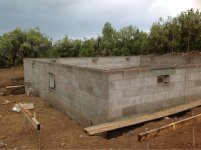dave1949
Super Star Member
I need to eat a little crow here. When I goggle "French drains" several pop up that are as the OP described.
I call those side drains or just under drains though most shown on Wiki have more elaborate top dressing then anything I've installed. They all appear to be quite functional as long as the bottom of the ditch is graded properly. I would think that loam and grass sod over the top of one would work but at a slower rate as long as the loam was more sand then clay.
I never really paid much attention to the definition. These types of drains have certainly changed over time with new materials and such.
At our old house, that had no gutters and I didn't want the headaches of the things anyways, I built a surface drain below the eaves by scooping out a shallow trough, laid heavy plastic in it, formed the outer edge with landscape timbers, and filled it with 1" to 1-1/2" washed stone. It was 40' long and about 2-1/2' wide with a good slope, at least as much as a normal drain line has.
So, I tested it to see how the water would run by laying the hose on the high end and letting it run. What happened was the stone saturated with water, but the water did not travel through the stone very quickly. It was spilling over the edges as much as running out the low end of the trough.
Okay, Plan B. I dug out enough stone to lay in a rigid 4" plastic drain pipe with holes and covered it with stone. That worked very well.
That is how I learned the relationship between the stones and the drain pipe. Stones alone do not transport water very well at all, which is why you rightly think poorly of that style of french drain.

